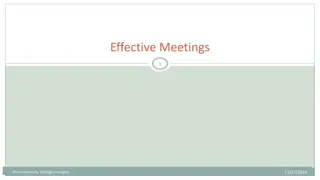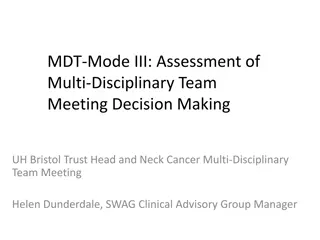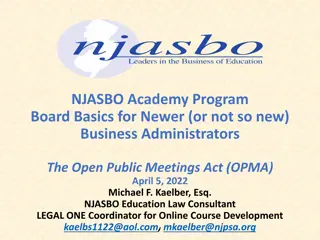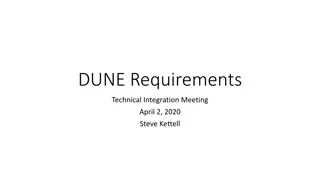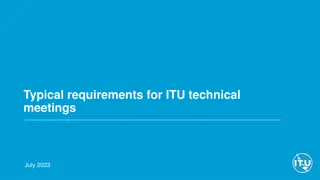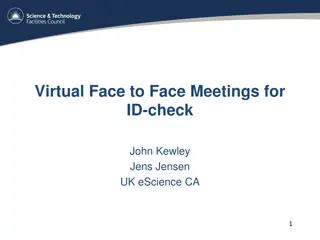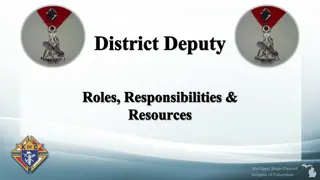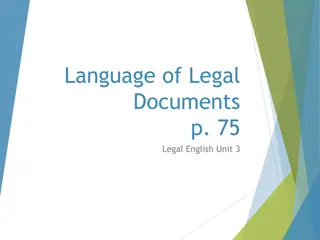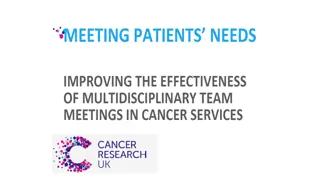Team Meetings and VM Requirements
"Team meetings with advisors and TA to discuss project plans and explore software tools like CyHELICS and OpenDSS. Detailed VM requirements for Ubuntu, Windows 10, and Kali with specific configurations. Recap of Docker usage and feedback received for project assignments."
Download Presentation

Please find below an Image/Link to download the presentation.
The content on the website is provided AS IS for your information and personal use only. It may not be sold, licensed, or shared on other websites without obtaining consent from the author.If you encounter any issues during the download, it is possible that the publisher has removed the file from their server.
You are allowed to download the files provided on this website for personal or commercial use, subject to the condition that they are used lawfully. All files are the property of their respective owners.
The content on the website is provided AS IS for your information and personal use only. It may not be sold, licensed, or shared on other websites without obtaining consent from the author.
E N D
Presentation Transcript
Timeline Mon Tues Wends Fri-Sun Team meeting with Dr. Ravikumar Self-Work Team meetings with TA and team work time Self-Work Past Week
VM Requirements Operating System: Ubuntu, Windows 10, Kali RAM: 16 GB Storage: 50 GB (for ubuntu and Kali), 100 GB (Windows 10 requires a lot of operation space) Architecture: 2 testing VMs per team member: 6 ubuntu, 6 windows 1 master set of VMs for the team, 1 ubuntu, 1 windows 1 Kali (at least. Maybe a Kali Purple VM too for defense?) Possibly 1 Kali Purple 16 total VMs: 7 ubuntu, 7 windows, 2 kali 4 Security onion virtual machines Programs/downloadables we ll be using: Helics, pandapower, opendss, visual studio, git, python NOTE FOR THE FUTURE: Security Onion requires 8 GB of RAM and 200 GB of free space so we will need those requirements in the future for both a Management node and a Search node. Instead of creating forward nodes on the other machines we can just have those machines forward their logs without installing a forward node (rsyslog for Ubuntu, will need to find another solution for Windows.
Recap & Feedback Met with Dr. Gelli Ravikumar and discussed using Docker and getting OpenDSS to work with OpenDER Met with our TA to discuss next week s assignments: Project plan assignment and lightning talk
Overview of Work Explore CyHELICS, pandapower, and OpenDSS Created Project Plan Lightning talk
Actual Work Met as a group to review last week s advisor meeting Talked over the Project Plan lightning talk and upcoming plans Started exploring using Docker with Helics and Pandapower Talked over possible power grid designs and OpenDSS Talked more over the broad scope of the project and what we want to focus on this semester Messed with Security Onion a little more - Tyler (didn t have time for much outside of the lightning talk)
Actual Work - Justin Worked a lot with the Docker files that will be used to compile our code.
Work - Zach Continued Testing PandaPower with more complex examples - - Using matplotlib to plot networks Working with different data structures Started Testing HELICS examples found on their github TODO: Understand the connection between pandapower and HELICS
Actual Work - Tommy PandaPower: Began to read through tutorials given by the developers to try to have a basis for when we create and simulate our grid Read through the basic introduction tutorials including Minimal example Showed the coding on how to create a very basic power system and the values from different analyses Creating a simple network Tutorial for the user to understand the pandapower datastructure and how to create networks through the pandapower API Showed code, a physical representation of what the code was creating, and how to confirm your creations were successful by checking various tables Running a power flow Imports previously made model, then shows various analysis codes and tables on different part of the model and equipment values Creating an advanced network Much more in depth model and the code to create it. Included residential loads, various voltage levels, generation components, external grid incorporation, etc.
Actual Work - Tommy Spent most of my time exploring the advanced example pictured on the right
Work - Matt OpenDER: Version 2.0 (current) includes photovoltaic (PV) and battery energy storage system (BESS) DER behaviors according to the capabilities and functionalities required by the IEEE standard 1547-2018. This project is licensed under the terms of the BSD-3 clause license. Runs with Python Looked through an example posted on GitHub that models a 1-1.10 pu voltage every 10 minutes Can model BESS and graph the stabilization of the power factor from the DER Can model the DER output power Can model the state of charge (SOC) and load capabilities of a BESS model I wasn't able to find anything specifically referencing the integration of OpenDER with OpenDSS, but both use python and developed by EPRI (Electric Power Research Institute).
Work - Kaya Project plan lightening presentation Created the slides on Wednesday, recorded on Saturday Docker Went through the Docker getting started and read through some of the manual pages Py_DSS Went through the getting started/experiment
Next Week's Plan Get access to, and set up the VMs Installing Helics, pandapower, openDSS, git, visual studio so this box can be copied out for all members Mess with OpenDSS, OpenDER, Py_DSS and Pandapower some more (and Security Onion)


